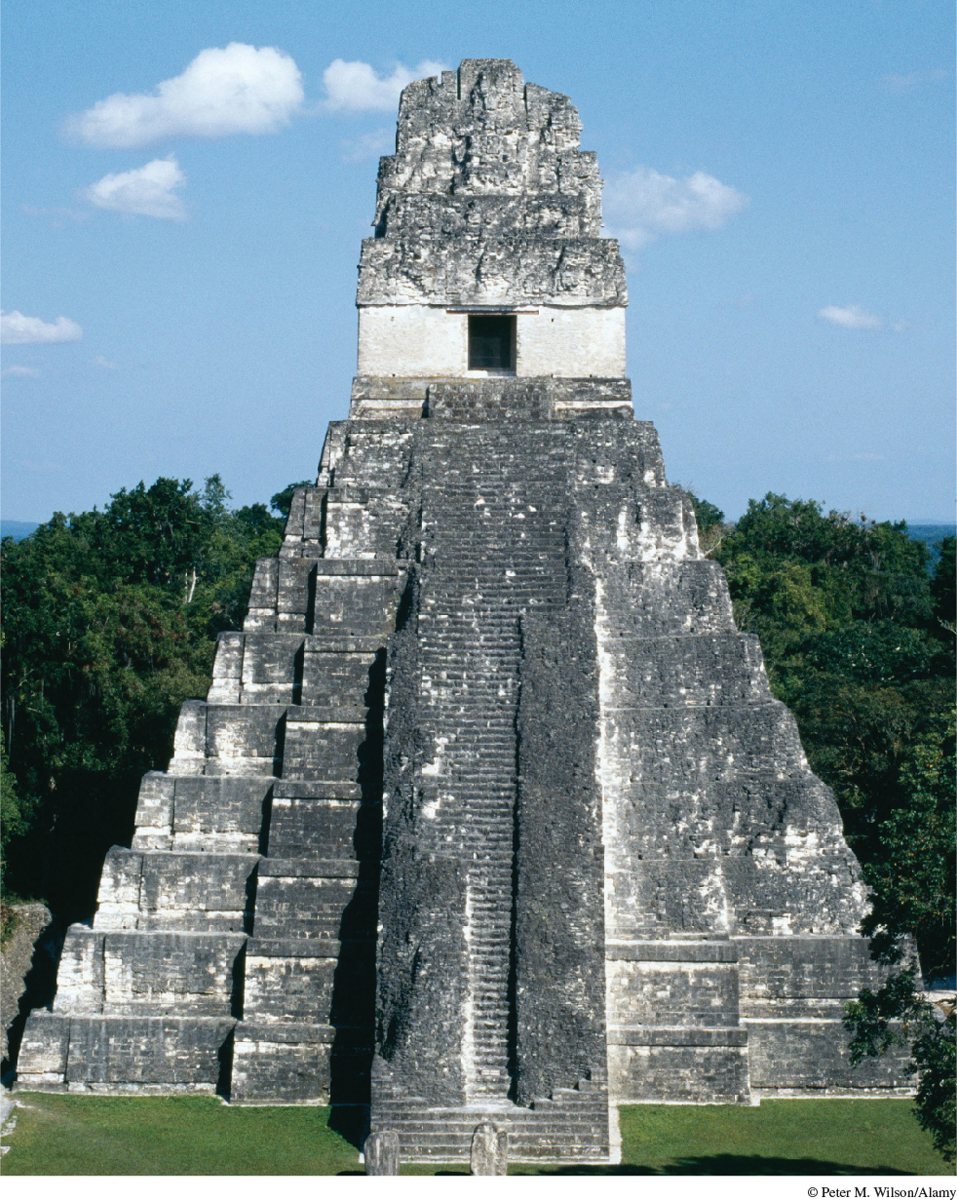Introduction to Chapter 6
Commonalities and Variations
Africa, the Americas, and Pacific Oceania 600 B.C.E.–1200 C.E.

© Peter M. Wilson/AlamyThe Maya Temple of the Great Jaguar in Tikal Located in the Maya city of Tikal in present-day Guatemala, this temple was constructed in the eighth century C.E. and excavated by archeologists in the late nineteenth century. It served as the tomb of the Tikal ruler Jasaw Chan K’awiil I (682–734). Some 144 feet tall, it was topped by a three-room temple complex and a huge roofcomb showing the ruler on his throne. Carved on a wooden beam inside the temple is an image of the ruler protected by a huge jaguar, along with illustrations of his military victories.
Meroë: Continuing a Nile Valley Civilization
Axum: The Making of a Christian Kingdom
Along the Niger River: Cities without States
Civilizations of Mesoamerica
The Maya: Writing and Warfare
Teotihuacán: The Americas’ Greatest City
Civilizations of the Andes
Chavín: A Pan-Andean Religious Movement
Moche: A Civilization of the Coast
Wari and Tiwanaku: Empires of the Interior
Alternatives to Civilization
Bantu Africa: Cultural Encounters and Social Variation
North America: Ancestral Pueblo and Mound Builders
Pacific Oceania: Peoples of the Sea
Reflections: Deciding What’s Important: Balance in World History
Zooming In: Piye, Kushite Conqueror of Egypt
Zooming In: The Lord of Sipan and the Lady of Cao
Working with Evidence: Axum and the World
In early 2010, Bolivian president Evo Morales was inaugurated for his second term in office, the only person from the country’s Native American population ever elected to that post since independence from Spain in 1825. The day before the official ceremony in the capital of La Paz, Morales traveled to Tiwanaku (tee-wah-NAH-coo), the center of an impressive empire that had flourished in the Andean highlands between 400 and 1000 C.E., long before either the Incas or the Spanish ruled the area. There he sought to link himself and his administration to this ancient culture, a symbol of Bolivian nationalism and indigenous pride. On his arrival, Morales was ritually cleansed with holy water and herbs and dressed in a llama wool robe. After offerings were made to Pachamama, an Andean earth goddess, and to Tata Inti, the Inca sun god, Morales was invested with symbols of both kingship and spiritual leadership, thus joining political and religious sources of authority. Proclaiming a new multinational state, Morales declared: “Gone forever is the colonial state, which allowed the looting of our natural resources, and gone also is the discriminatory [against native peoples] colonial state.”1 This recent ceremony provides a reminder that memories of American second-wave civilizations remained alive and were available for mobilizing political support and legitimating political authority in the very different circumstances of the early twenty-first century.
F or many people, the second-wave era evokes most vividly the civilizations of Eurasia — the Greeks and the Romans, the Persians and the Chinese, and the Indians of South Asia — yet those were not the only civilizations of that era. During this period, the Mesoamerican Maya and the Andean Tiwanaku thrived, as did several civilizations in sub-Saharan Africa, including Meroë (MER-oh-ee), Axum (AHK-soom), and the Niger River valley. Furthermore, those peoples who did not organize themselves around cities or states likewise had histories of note and alternative ways of constructing their societies, although they are often neglected in favor of civilizations. This chapter explores the histories of the varied peoples of Africa, the Americas, and Pacific Oceania during this phase of world history. On occasion, those histories will extend some centuries beyond the chronological boundaries of the second-wave era in Eurasia because patterns of historical development around the world did not always coincide precisely.
| A MAP OF TIME |
| 1400–800 B.C.E. |
Lapita culture in Oceania |
| 900–200 B.C.E. |
Chavín religious movement in Peruvian Andes |
| 730 B.C.E. |
Nubian conquest of Egypt |
| 300 B.C.E.–100 C.E. |
Kingdom of Meroë in upper Nile Valley |
| 300 B.C.E.–900 C.E. |
Niger Valley civilization in West Africa |
| 200 B.C.E.–400 C.E. |
Hopewell “mound-building” culture in U.S. eastern woodlands |
| 1st–8th centuries C.E. |
Flourishing of Axum (East Africa) and Moche (coastal Peru) civilizations; spread of Bantu-speaking people in eastern and southern Africa |
| 250–900 C.E. |
Classical Maya civilization |
| 300–600 |
Flourishing of Teotihuacán |
| 4th century |
Introduction of Christianity to Axum |
| 400–1000 |
Tiwanaku and Wari in the Andes |
| 860–1130 |
Chaco culture in U.S. Southwest |
| 900–1250 |
Cahokia |
| After 1000 |
Flourishing of Tonga trading network |
| 1100–1600 |
Saudeleur dynasty on island of Pohnpei |
| 1200 |
Initial settlement of New Zealand |
SEEKING THE MAIN POINT
To what extent did the histories of Africa and the Americas parallel those of Eurasia? In what ways did they forge new or different paths?
